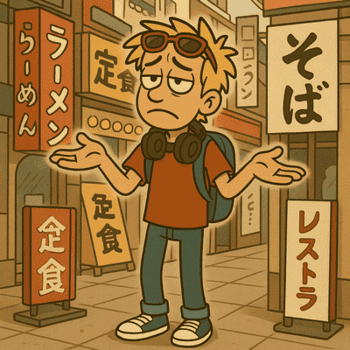
Sure, some of Japan’s most popular restaurants require reservations well in advance. But let’s be honest—no one maps out every single meal before a trip. More often than not, you’ll find yourself hungry and searching for a place to eat on the fly.
To enjoy a satisfying meal in Japan—a land overflowing with eateries of all shapes and sizes—you’ll want to know how to find good restaurants without falling into tourist traps.
You know, those places that look great in photos but leave you wanting to go back in time and give your past self a stern lecture.
Not every place that looks promising actually delivers. Some restaurants spend more on flashy ads than fresh ingredients, while others ride on their prime location alone, serving food that’s just… fine.
In this article, I’ll show you how to spot the truly great places to eat—while also taking a closer look at some common myths found in “how-to” guides, which are sometimes written by non-Japanese authors or by those who may not have a deep understanding of Japan’s food culture.

1. How to Find a Great Restaurant
Before diving into how to actually find a good restaurant, let’s take a moment to ask: What even makes a restaurant “good”?
1-1. What Defines a Good Restaurant?
- The price is reasonable (or pleasantly cheap) for the quality of food and service.
- The interior and customer service make you feel welcome.
- It’s a place locals actually go to—not just a tourist magnet.
With that in mind, one of the first things you might want to skip is the travel guidebook.
It’s hard to believe the editors have personally visited every restaurant featured in the book—let alone the ones tucked away in the advertisement section.
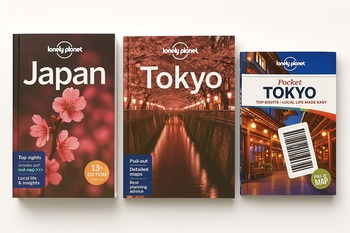
Try flipping through a guidebook for your own country sometime. Would you honestly eat at most of the places they recommend? Probably not. You’re unlikely to find the kind of spots that are affordable and genuinely good.
1-2. How Can You Find a Restaurant Without Relying on Guidebooks?
Sure, searching online is the obvious move these days.
But even then, with all the options out there—Google Maps, TripAdvisor, Instagram, YouTube—you might find yourself wondering: Which one actually works best?
As someone who lives in Japan, I can say this with confidence:
Use Tabelog.
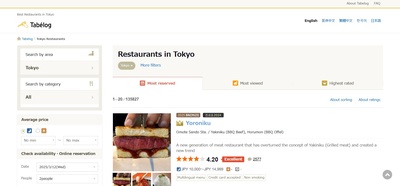
Tabelog is Japan’s most widely used restaurant platform, with the largest number of listings. It’s so common that basically every Japanese person uses it to find somewhere to eat.
Restaurants are rated on a five-star scale, primarily based on reviews from actual diners (though I’ll explain some additional factors later on). And because Tabelog verifies its reviewers, it’s much harder for tourist-focused places to game the system with fake ratings.
Using it is simple: enter your location and preferred cuisine, and you’ll get a well-organized list with all the essentials—map, hours, payment types, and more. Most listings include detailed user reviews, so you can get a real feel for the place before you go.
If the restaurant supports it, you can even book a reservation directly through the site.
If you’re looking for places to eat in Japan, Tabelog should be your go-to.
1-3. The Truth Behind Tabelog
I’ve just finished singing the praises of Tabelog, but don’t worry—I don’t work there, and I don’t get paid to say any of this.
To prove it, let’s take a look at the platform’s darker side—and how to avoid getting fooled by it.
The biggest advantage of Tabelog is that every restaurant has a visible rating, making it easy to compare at a glance. But in Japan, it’s widely known that these scores can be… let’s say, a little mysterious.
For example, let’s say a restaurant gets two reviews: one with a score of 3.0 and one with 4.0.
Naturally, you’d expect the final score to be 3.5. Anything else would make all those hours we spent sweating over math in elementary school feel meaningless.
But when you actually look up the restaurant on Tabelog, that’s not always the case.
You might find yourself wondering, Tabelog, are you okay?
Here’s the deal: yes, the individual review scores do influence the final rating—but only to a certain extent. The final number is adjusted and set by Tabelog itself.
In other words, the platform reserves the right to tweak scores as it sees fit.
(Not because the CEO failed math class, just to be clear.)
To be fair, relying 100% on raw user ratings could cause its own issues, so maybe the system is designed for balance.
Still, things aren’t so simple. It’s been reported that restaurants not enrolled in Tabelog’s paid membership plan may see their scores lowered.
On top of that, it’s believed that some places pay for fake positive reviews.
And based on my own dining adventures, I can confirm: there are definitely highly rated places that don’t live up to the stars.

So, the takeaway here is: don’t rely on the rating alone.
It’s a helpful reference—but only if you know how to read between the lines.
Is Tabelog Still Worth Using?
With all that said, is Tabelog still the best option?
Yes—without question.
Tabelog has an English version, which works well for basic restaurant searches in major cities. While it doesn’t include all the features of the Japanese site, it’s still a practical option for most travelers. Even without fancy filters, the reviews—written by real locals—offer far more genuine insight than most other platforms.
If you’re simply looking for tourist-friendly restaurants with English menus, TripAdvisor or Google Maps might do the job. But if you want to eat where the locals eat, Tabelog is still your best bet—even in English.
If you’re looking for more detailed search options—or if you’ve used Google Translate before—consider giving the Japanese site a try. You’ll find advanced filters like late-night hours, counter seating, and non-smoking options that help you narrow down exactly what you’re craving.
It takes a little effort, but for anyone serious about food, it’s absolutely worth it. Used wisely, Tabelog remains one of the most powerful tools for discovering great food in Japan.
1-4. How to Use Tabelog Effectively
Tabelog has earned a reputation for being more reliable than other platforms, thanks to its large number of users and reviews.
But what if the scores themselves can’t always be trusted?
They’re not completely unreliable—but let’s say some ratings are… more equal than others.
That’s why the smartest way to use Tabelog is to first pick a few places that catch your eye,
and then cross-check them using other sources like Google Maps, Instagram, or YouTube.
You don’t have to go full detective mode—just doing a quick search for 2–3 places you’re curious about can go a long way.
A few extra minutes online could mean the difference between just okay and absolutely unforgettable.
And there’s one more tip worth knowing.
On restaurant review platforms in general—including Tabelog, Google Maps, and others—higher-priced restaurants often receive better ratings. This isn’t always because the food is objectively better. It’s often about overall satisfaction, which can be heavily influenced by how much money was spent.
As a result, the highest-rated restaurants on Tabelog are mostly high-end establishments. That’s why I believe the best way to find good, reasonably priced restaurants is to do your own research rather than just relying on Tabelog’s top-ranked listings.

2. Truths and Myths About Finding a Good Restaurant in Japan
Now that you’ve got Tabelog—a powerful tool for finding restaurants in Japan—you’re already ahead of the game.
But just like a sharp kitchen knife, a great tool can only take you so far without the right technique.
To truly make the most of it, you’ll want to sharpen your sense of how to judge a good restaurant.
As someone living in Japan, I’ve seen plenty of advice in foreign media about how to find great places to eat here.
Some of it is helpful. Some… not so much.
So in this section, we’ll take a closer look at a few common “rules of thumb” and see which ones are actually worth trusting.
2-1. Avoid restaurants that put effort into takeout.
Verdict: False
This idea may come from the belief that only restaurants focusing exclusively on dine-in service can be truly great.
Or perhaps it was started by well-meaning drivers who’ve had one too many close calls with an Uber Eats cyclist weaving through traffic.
But in reality, the rise of delivery services has led many quality restaurants to embrace takeout as part of their business model.
In my experience, a restaurant that handles both in-house dining and takeout can still serve excellent food.
It’s not something I’d personally use as a deciding factor.
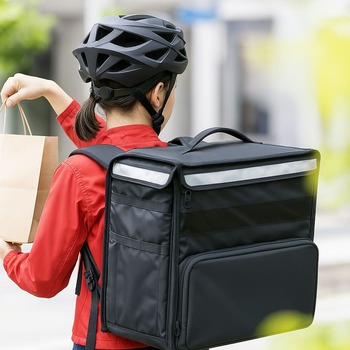
2-2. Avoid restaurants in heavily touristy areas.
Verdict: True (with nuance)
This one has some truth to it.
In major tourist zones, especially those with high land and rental costs, it’s often difficult for restaurants to strike a good balance between quality and price.
Some restaurants, especially newer ones, may rely more on location than food quality.
They sometimes overcharge and underdeliver.
That said, not every restaurant in a touristy spot is bad.
Not all politicians are corrupt, and sometimes, toast really does land butter-side up.
A bit of caution is all it takes to find a truly good spot, even in busy areas.

2-3. If a place is full of locals, it must be good.
Verdict: Often true, but context matters.
Seeing a restaurant packed with locals can definitely be a good sign—it usually means the place has earned steady support from people in the area.
But here’s the catch: why are they going there?
Sometimes it’s about more than just the food.
Maybe the portions are huge, it’s super cheap, or it’s close to a school or office.
That doesn’t always mean it’s the best choice for travelers looking for quality or atmosphere.
This is where Tabelog really shines.
Its reviews don’t just give scores—they often explain why people like the place.
A quick glance at a few comments can tell you whether it’s loved for its flavor, its value, or just sheer convenience.

2-4. Chain restaurants aren’t worth your time.
Verdict: False
It’s easy to assume that chain restaurants are low-quality and generic, especially if you’re comparing them to fast food chains in your home country.
But in Japan, many chain restaurants offer great value, decent quality, and fast service—and locals use them regularly.
From conveyor-belt sushi to curry houses and gyudon chains, these places often deliver a surprisingly satisfying meal.
They can also be a great way to experience everyday Japanese food culture.
Of course, they won’t offer the same charm or uniqueness as small, family-run restaurants—but for a quick, reliable meal, they’re hard to beat.
2-5. If it’s highly rated or Michelin-listed, it must be great.
Verdict: Sometimes true—but not always a match.
Of course, the Michelin Man still has an excellent palate, and we’re not suggesting you go up against seasoned food critics without doing your homework.
Michelin stars and high ratings do reflect quality—that much is true.
But that doesn’t mean the experience will suit everyone.
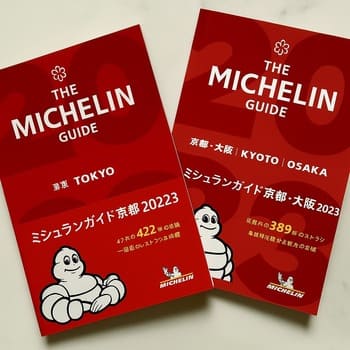
Some places are too formal, too expensive, or simply not your style.
And sometimes, the hype creates expectations that are just too high to meet.
In the end, taste is personal.
Use ratings as a guide—but don’t let them dictate your experience.
3. Conclusion: Find What Tastes Right—for You
Finding a good restaurant might sound easy, but it’s not always so simple—especially when you’re in an unfamiliar place.
There’s no such thing as the “perfect” restaurant for everyone.
High ratings, convenient locations, or a crowd of locals can all be useful clues—but none of them tell the whole story.
That’s why it helps to stay curious.
Use Tabelog as your trusted tool, and take a closer look at what Japanese restaurants truly have to offer.
Following someone else’s list of top-rated spots can be fun,
but sometimes, it feels like something’s missing—like it’s lacking that one final touch.
That feeling you get when you walk into a place you chose, after a bit of searching and a bit of doubt—
that might just be the spice that brings your whole trip to life.
You might also like:



